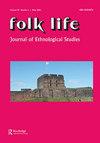Fantastic changelings: liminality and narrative technique in Irish changeling tales
IF 0.1
4区 社会学
0 FOLKLORE
引用次数: 0
Abstract
Folk beliefs around changelings, iarlaisí in Irish, are numerous in Ireland: fairies would take humans away to the Otherworld, while leaving a substitute in place of the stolen person. A number of studies have been carried out that highlight the aetiological origins of changeling folklore: these narratives would rationalize otherwise inexplicable disabilities and illnesses, such as failure to thrive. Despite the extensive scholarship on this aspect of folk belief and that ‘it may seem there is little left to add’ according to Linda-May Ballard, analysis of changeling tales has taught us that further insights can still be found within them. Consequently, this study analyses changeling narratives in Irish folklore, both in English and in Irish, and focuses on liminality in the Irish changeling tradition as a way to achieve such new understandings. The accounts under examination here focus on those in which the family brutally gets rid of the changeling. I exclude stories in which the fairy creature demonstrates extraordinary capacities for music or speech for example. Simply put, this enquiry examines narratives featuring motif F321.1.4, paying particular attention to the way the fairy interloper is driven out, according to Stith Thompson’s classification. Liminality, the quality of something which is situated, to take up Victor Turner's phrase, ‘betwixt and between’ two spaces or states, physical or metaphorical, is central to changeling tales. The term, popularised by Arnold Van Gennep in his ethnographical study The Rites of Passage, designates the character of that which belongs to these thresholds, be they a dividing line or a border space, and of that which therefore holds characteristics of both worlds on either side of it. The liminality of these accounts, expressed through their characters, settings and plots is also studied through its relationship with the narrative technique of the fantastic. Indeed, the changelings, half-human, half-fairy, are embodiments of liminality in the narratives. Yet the characters are not the only ones to be found on the threshold between worlds. Places, times and even narrative technique similarly possess an in-between dimension. This study centres specifically on the fantastic, a process that blurs the boundaries between the real and the imagined, theorized by Tzvetan Todorov amongst others, as it神奇的变化:爱尔兰变化故事的界限与叙事技巧
关于换生灵的民间信仰,爱尔兰语iarlaisí,在爱尔兰有很多:仙女会把人类带到另一个世界,而留下一个替代品来代替被偷走的人。许多研究都强调了换生灵民间传说的病因学起源:这些叙述将使其他无法解释的残疾和疾病合理化,比如无法茁壮成长。尽管在民间信仰的这方面有广泛的学术研究,而且根据琳达-梅·巴拉德(Linda-May Ballard)的说法,“似乎没有什么可以补充的了”,但对换灵故事的分析告诉我们,仍然可以在其中找到进一步的见解。因此,本研究分析了爱尔兰民间传说中的换生灵故事,包括英语和爱尔兰语,并将重点放在爱尔兰换生灵传统中的阈限上,以此作为实现这种新理解的一种方式。这里要考察的是那些家族残忍地除掉换子人的故事。我排除了精灵生物在音乐或语言方面表现出非凡能力的故事。简单地说,根据Stith Thompson的分类,这个调查研究了以主题F321.1.4为特征的叙事,特别关注了仙女闯入者被赶出去的方式。阈限,即某种事物的品质,用维克多·特纳的话来说,“介于”两个空间或状态之间,无论是物理的还是隐喻的,是改变故事的核心。这个词是由Arnold Van Gennep在他的民族志研究《通过的仪式》中推广的,它指的是属于这些门槛的特征,无论它们是分界线还是边界空间,因此在它的两边都具有两个世界的特征。这些叙述的阈限性,通过人物、背景和情节来表达,也通过它与奇幻叙事技巧的关系来研究。事实上,半人半仙的换生灵,是叙事中阈限性的体现。然而,角色并不是唯一出现在两个世界之间的角色。地点、时间甚至叙事技巧都同样拥有一个中间维度。这项研究的重点是幻想,这是一个模糊现实和想象之间界限的过程,兹维坦·托多罗夫等人提出了这一理论
本文章由计算机程序翻译,如有差异,请以英文原文为准。
求助全文
约1分钟内获得全文
求助全文
来源期刊
CiteScore
0.30
自引率
66.70%
发文量
17
期刊介绍:
Folk Life: Journal of Ethnological Studies is a journal devoted to the study of all aspects of traditional ways of life in Great Britain and Ireland. The journal publishes original, high quality, peer-reviewed research in the form of unsolicited articles, solicited papers (which are usually selected from those read at the Society"s annual conference) and of members" papers (which are usually short reports of work in progress). Work published in Folk Life may include, for example, papers dealing with the traditional ways of life of other countries and regions, which may be compared to or contrasted with those of Great Britain and Ireland.

 求助内容:
求助内容: 应助结果提醒方式:
应助结果提醒方式:


